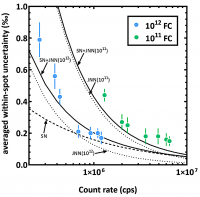Bouden, N. ; Villeneuve, J. ; Marrocchi, Y. ; Deloule, E. ; Füri, E. ; Gurenko, A. ; Piani, L. ; Thomassot, E. ; Peres, P. ; Fernandes, F. (2021) Frontiers in Earth Science, 8:601169
Voir en ligne : https://www.frontiersin.org/articles/10.3389/feart.2020.601169/full

Abstract :
Secondary ion mass spectrometry (SIMS) is a powerful technique for in situ triple oxygen isotope measurements that has been used for more than 30 years. Since pioneering works performed on small-radius ion microprobes in the mid-80s, tremendous progress has been made in terms of analytical precision, spatial resolution and analysis duration. In this respect, the emergence in the mid-90s of the large-radius ion microprobe equipped with a multi-collector system (MC-SIMS) was a game changer.
Further developments achieved on CAMECA MC-SIMS since then (e.g., stability of the electronics, enhanced transmission of secondary ions, automatic centering of the secondary ion beam, enhanced control of the magnetic field, 1012Ω resistor for the Faraday cup amplifiers) allow nowadays to routinely measure oxygen isotopic ratios (18O/16O and 17O/16O) in various matrices with a precision (internal error and reproducibility) better than 0.5 ‰ (2σ), a spatial resolution smaller than 10 μm and in a few minutes per analysis. This paper focuses on the application of the MC-SIMS technique to the in situ monitoring of mass-independent triple oxygen isotope variations.



